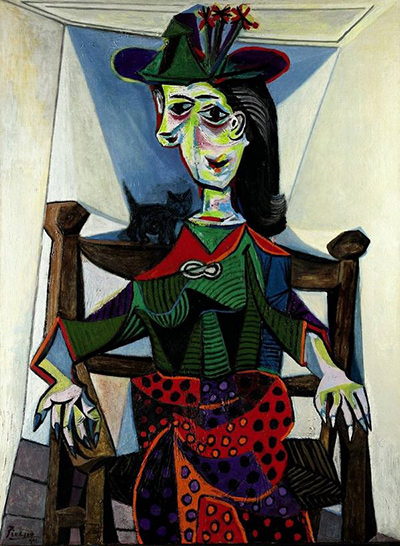The various ladies in his life played a significant role as both muses for his work and influences on his development as an artist, which featured many different periods as he sought to push his talents down as many avenues as possible.
This flattering, vibrant portrait pays the greatest respect to Dora Maar, concentrating most of her face and attire, with very little attention to the background. The elongated fingers is a style used consistently by Picasso, such as in Le Rêve. This three-quarter length portrait sits her in a simple wooden chair, with a small black cat sat over her shoulder.
Pablo, of course, was famous for his love of both women and animals, incorporating various examples of both of them into his work on many occasions. Cats can hold great symbolic powers, sometimes seen as independant, even sinister, whilst other times representing innocence, comfort and beauty.
The cat featured here is probably used as a symbol of the feminine sexual values of Pablo Picasso's mistress and speaks directly to the viewer about the main focal point of this portrait. The feline theme continued with Cat and Cat and Bird.
The use of colour in this artwork is one of the reasons for the artist's enjoyment of the finished piece. It captured some of his feelings towards Dora Maar and offered others an insight into their relationship. Several items which were characteristic of the woman are to be found carefully added to this canvas, such as her hat for which she was roundly remembered for regularly wearing. Many have argued that the inclusion of the hat in this artwork also points to her involvement in the Surrealist movement.
The cubist approach to Dora Maar's torso gives a three-dimensional look, almost as if a sculptured statue. Whilst the background is simple in content, just some floorboards and interior space, the artist still managed to create some interest around it by imparting his cubist approach here too.
There is a clearly regal look to Dora Maar in this artwork, sat proudly like a queen surveying her subjects from a throne. The final canvas measures 128.3 cm by 95.3 cm.
Who was Dora Maar?
Dora Maar was a significant influence on Pablo, well beyond just being another of his mistresses. She was an intelligent woman who would discuss political issues of the day with him, and he found her to be inspiring. As an artist, they would share ideas and she was much more of an equal to Pablo than he was with his other women. As far as he was concerned, there was raw passion, but also considerable respect.
As a fluent Spanish speaker, Dora Maar could connect easily with Pablo and they also both leaned left, politically. The best comparison of their relationship could perhaps be the marriage of independantly minded, portrait painter Frida Kahlo and the Mexican muralist, Diego Rivera.
Dora was an established photographer who took the only visual documentation of Picasso's Guernica in development. The artist would go to extraordinary lengths in order to ensure that the final artwork was to his satisfaction, producing endless study sketches of various elements of the piece.
History of the Ownership of the Dora Maar Painting
This was a truly personal artwork which helped it to command such a huge price at sale in 2006, making it one of the most expensive art purchases in history.
Initially, the painting was purchased in the 1940s by two art collectors from Chicago. It was then sold on by Leigh and Mary Block in 1963 and at that point the painting was not displayed publically until the turn of the century.
It was then, around 2005-2006, that the famous painting re-appeared, going on display in some of Sotheby's most significant auction halls, before going under the hammer in May, 2006. The Gidwitz family of Chicago received the second-highest price ever paid for an oil painting at auction, anywhere in the world. The final price of US$95,216,000 is believed to have been paid by an anonymous Russian, paying almost twice the pre-sale estimate.
The lavish spender also snapped up a Monet seascape and a Marc Chagall original too in an extraordinary display of wealth. He who bidded in person is likely to have been doing so on behalf of someone else, but no link has ever been established. The Georgian mining magnate Boris Ivanishvili is the most likely candidate, having sold his bank a week before the auction although this has never been confirmed.

